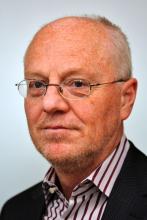BOSTON – Noninvasive vagus nerve stimulation (nVNS) proved safe and effective for the treatment of episodic cluster headaches in the pivotal, multicenter ACT2 study.
The findings confirmed those of the ACT1 study – and together, the results led to the April 18 approval by the Food and Drug Administration of the gammaCore stimulation device for the treatment of episodic cluster headaches (eCH).
In ACT2, nVNS was used to treat 495 cluster headache attacks in 50 patients randomized to the treatment group, and a sham treatment was used for 400 attacks in 52 patients. The proportion of patients who achieved pain freedom within 15 minutes (responders) was 13.5% with stimulation, compared with 11.5% with the sham treatment (odds ratio, 1.22).
However, the effects of stimulation were much more striking among those with eCH, compared with those with chronic cluster headaches (cCH), Peter J. Goadsby, MD, reported in a poster at the annual meeting of the American Academy of Neurology. The findings were also presented during an emerging science session at the meeting.Stimulation led to pain freedom within 15 minutes in 47.5% of 101 attacks in 14 patients with eCH, compared with 6.2% of 81 attacks in eCH patients in the sham treatment group (OR, 9.19), said Dr. Goadsby of King’s College, London. Conversely, the proportion of responders was only 4.8% with stimulation for 394 attacks in 34 patients with cCH, compared with 12.9% in 319 attacks in 31 patients in the sham treatment group (OR, 0.41).
Further, the proportion of patients with any type of cluster headache who achieved responder status for at least 50% of attacks was 39.5% with stimulation vs. 13.6% with sham. Among those with eCH, the proportions were 64.3% and 15.4%, respectively, and with cCH they were 29.4% and 12.9%, respectively.
Study patients were adults with eCH or cCH who were enrolled from nine tertiary care centers in four European countries. Patients agreed to not start any new treatment and to not change the dose of any existing treatment during a 1-week run-in period and during a 2-week double-blind period.
Vagus nerve stimulation was self administered using the gammaCore study device at the onset of a cluster headache attack. Three consecutive 120-second stimulations were administered, and if pain freedom was not achieved by 9 minutes, three additional stimulations could be administered.
Patients were asked to refrain from use of rescue treatments for 15 minutes after beginning stimulation (use of rescue treatments constituted a treatment failure), and an initial assessment of pain intensity was conducted at 15 minutes. All patients were eligible for nVNS during a 2-week open-label period after the double-blind period. Patients recorded cluster headache attack data in diaries.
Treatment was safe and well tolerated. A total of 20 and 14 patients in the treatment and sham groups experienced adverse events in the double-blind period (total number of events, 65 and 39, respectively); and 9 and 10 in the groups, respectively, experienced adverse drug events. The adverse events occurring more often in the treatment group included application-site irritation in two patients, application-site paresthesia in two patients, and skin irritation in two patients.
Vagus nerve stimulation is a well-established neuromodulation therapy for epilepsy and medication-resistant depression. The gammaCore device used in the ACT1 and ACT2 studies delivers treatment to the cervical branch of the vagus nerve transcutaneously, whereas prior methods involved surgically implanted devices, which are more prone to cause infection and other complications and costs.
The current study’s findings demonstrate the superiority of nVNS over sham therapy for the acute treatment of attacks in patients with eCH, Dr. Goadsby noted. The lack of benefit in those with cCH likely affected the results for the total population, he added.
The findings indicate the nVNS can be safely and easily incorporated into existing therapeutic regimens, Dr. Goadsby concluded.
The ACT1 and ACT2 studies were sponsored by electroCore, the maker of gammaCore. Dr. Goadsby reported receiving funding from electroCore and numerous other companies. He also reported having a pending patent for magnetic stimulation for headache.


